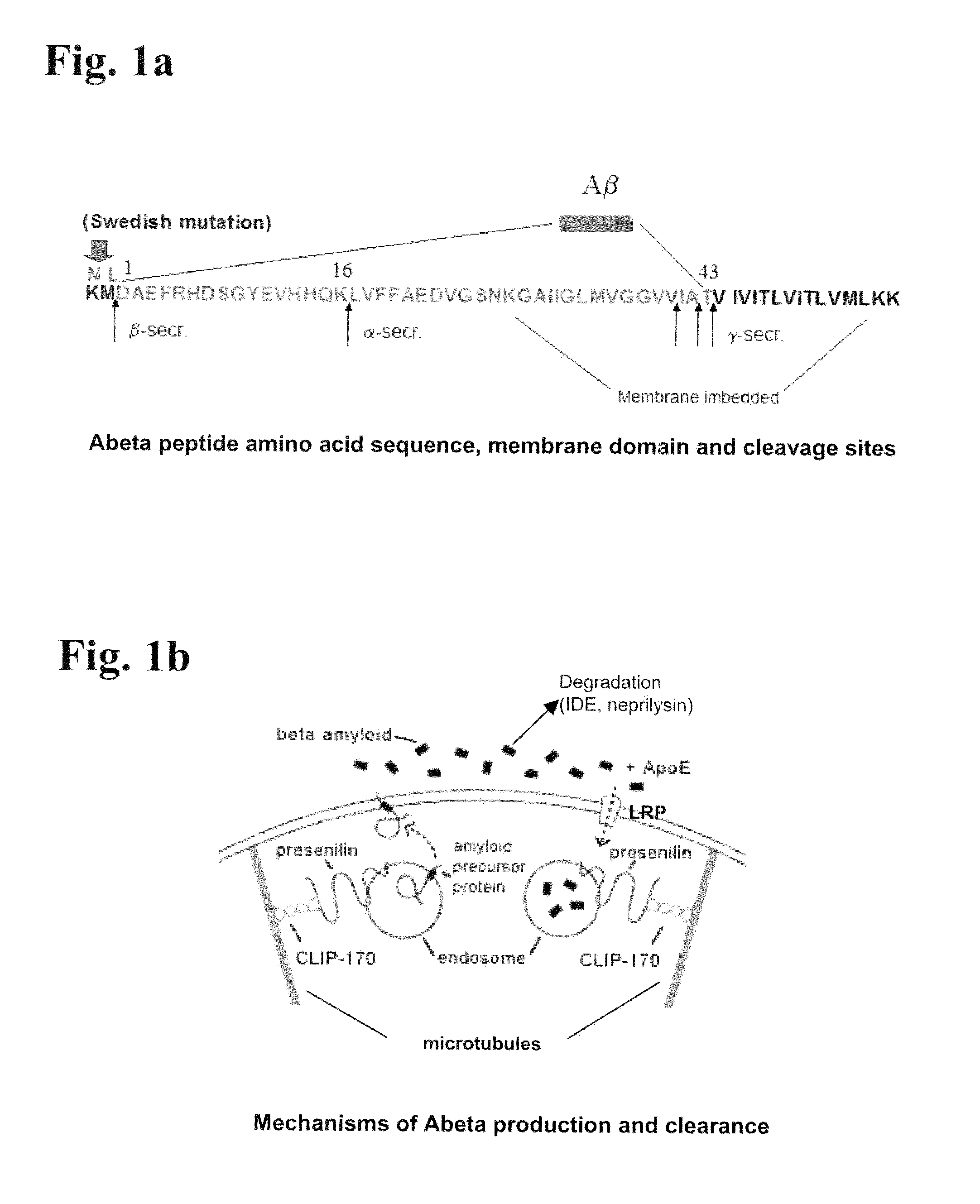Fragments, Mutants and Chimeric Fusion Proteins of Leptin For Treating Alzheimer's Disease
a technology of chimeric fusion protein and leptin, which is applied in the field of fragments, mutants and chimeric fusion proteins of leptin for treating alzheimer's disease, can solve the problems of reducing the axonal transport efficiency of leptin, unable to demonstrate the targeted condition's efficacy, and unable to secrete truncated molecules from adipocytes, so as to reduce amyloid (a
- Summary
- Abstract
- Description
- Claims
- Application Information
AI Technical Summary
Benefits of technology
Problems solved by technology
Method used
Image
Examples
example 1
The Effects of Leptin on Aβ Production In Vitro
[0189]Human (SY5Y) or mouse neuroblastoma cell-lines (Neuro2a) commonly are used to study amyloid 13 metabolism in vitro. Neuro2a cells are stably transfected with hyg-sal 34 (SEQ ID NO: 11), a plasmid driving the expression of a recombinant fusion protein containing the human C-terminal fragment of APP of about 134 amino acids, CAPP134 (SEQ ID NO: 10), Here, 5Y5Y or Neuro2a cultures were treated for 2 or 5 h with about 100 ng / ml or about 400 ng / ml leptin (FIG. 4a, 4b) Similarly, primary neurons from embryonic rat brain, infected with an adenovirus to direct the expression of CAPP 134 (SEQ ID NO:10) also were treated according to the same regimen.
[0190]FIG. 4 shows that leptin affects Af3 production through BACE in rafts. In panel (a), Neuro2a cells stably transfected with hyg-sa134 were treated for about 2 h or about 5 h with about 100 ng / ml leptin, Ob (black); about 125 mg / ml cyclodextrin, CDX (striped gray); about 5 mg / ml cholesterol...
example 2
[0209]Plasma leptin levels were measured in transgenic mice engineered to express mutations linked to familial AD: APP with the Swedish mutation (APPswe) (SEQ ID NO: 13), PS1 with the M146V substitution (PS1M146V) (SEQ ID NO: 15), and both APPswe (SEQ ID NO: 13) and PS1M146V (SEQ ID NO: 15). Among those, only the transgenic mice expressing APPswe exhibit AD-like pathology. The APPswe-expressing mice in the PS1M146V background exhibit AD-like pathology at a younger age (6 months). The PS1M146V mice do not develop AD-like pathology.
[0210]FIG. 7 shows a deficiency of leptin in AD transgenic mice and the effect of leptin supplementation on amyloid load. In panel (a), plasma leptin was quantified in one year old mice with the following genotypes: i) double mutant APPswe / PS1M146V ii) single mutant PS1M146V and wild-type (a cross between C57BL / 6Ntac and B6SJLF1). Asterisk indicates that value is significantly different to that of non-transgenic controls (set at pJ Ne...
example 3
Effect of Metabolic Challenges on Neuronal Cell Viability
[0215]Doses of cholesterol which decreased neuronal viability by 25-50% (27.5 μg / mL) after 18 h treatment (data not shown) were used to determine whether co-treatment with full length or fragments of leptin at a range of concentrations could attenuate the toxic effects of the cholesterol (FIG. 9). RA-SY5Y were treated for 18 h with full length or fragments of leptin ranging from 5 nM (white bars) to 500 nM (black bars), or no leptin control (checkered bars) in the presence (FIG. 9B) or absence (FIG. 9A) of cholesterol, and cell viability measured. Cholesterol insult induced a decrease in cell viability in the range of 35±5% when treated without Leptin (9B; checkered bar). Full length and fragments of leptin showed no effect on cell viability in the absence of cholesterol (FIG. 9A), while full length and Lep (22-56) trended towards increased viability in the presence of cholesterol at all doses (FIG. 9B; second and third group ...
PUM
| Property | Measurement | Unit |
|---|---|---|
| Dimensionless property | aaaaa | aaaaa |
| Dimensionless property | aaaaa | aaaaa |
| Cell angle | aaaaa | aaaaa |
Abstract
Description
Claims
Application Information
 Login to View More
Login to View More - R&D
- Intellectual Property
- Life Sciences
- Materials
- Tech Scout
- Unparalleled Data Quality
- Higher Quality Content
- 60% Fewer Hallucinations
Browse by: Latest US Patents, China's latest patents, Technical Efficacy Thesaurus, Application Domain, Technology Topic, Popular Technical Reports.
© 2025 PatSnap. All rights reserved.Legal|Privacy policy|Modern Slavery Act Transparency Statement|Sitemap|About US| Contact US: help@patsnap.com



